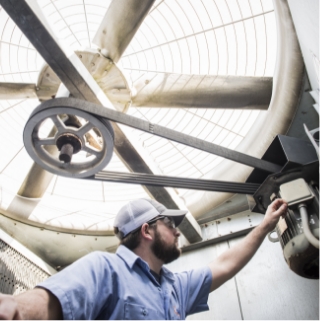Improving the Efficiency of Existing Systems
Initially, we'll need to adopt smarter technologies that allow our existing cooling systems to operate more efficiently. By reducing the consumption of our existing systems, we can move towards more efficient cooling. Several new technologies are making this possible:Artificial Intelligence (AI)
There’s been a lot of buzz in recent years about the rise of artificial intelligence systems, “smart” computer systems that can collate data from several different sources, “learn” from human interactions, and then use all of that information to provide incredibly detailed conclusions or provide granular control over complex systems. In the world of HVAC, we’re now seeing AI-driven controls and monitors that can provide increased efficiencies in existing cooling systems. AI-powered occupancy and thermometer systems can learn from a facility's cooling needs, interpret weather conditions and occupancy patterns, and provide effective real-time control of a complete commercial HVAC system to ensure that energy expenditures remain as low as possible while still providing adequate cooling for the people inside. In addition, AI monitoring systems are being developed to assess data from sensors inside an HVAC system to predict equipment failures and identify inefficiencies due to suboptimal system performance. These systems won't only save owners and operators millions of dollars in repair and replacement costs but will also ensure that systems operate smoothly and efficiently without wasting energy on overcoming friction from bad bearings, compensating for refrigerant leaks, or trying to force air through clogged or dirty ductwork.Internet of Things (IoT)
Once a buzzword in the tech industry and now a normal part of life for millions, the Internet of Things (IoT) is a collective name for internet-connected devices other than computers, tablets, and mobile phones. If you have a Ring doorbell or a washing machine that sends a text alert once the spin cycle is complete, you're enjoying the IoT. For commercial heating and cooling systems, IoT sensors, thermostats, and other connected devices help keep owners and operators updated on system status, provide remote control of HVAC systems, and generate detailed usage data that can inform future decisions. By allowing this real-time monitoring of systems and around-the-clock control, IoT devices added to an existing HVAC system can dramatically increase the system's efficiency and reduce energy expenditures.Renewable Energy
One of the fastest-growing sectors of the energy market is renewable energy, using energy sources such as solar and wind to generate electricity on-site to power a facility's HVAC equipment. Doing so is becoming increasingly affordable as new technologies continuously lower the cost of adoption. While typically requiring a fairly significant upfront investment, adding renewable power generation to your plant will pay for itself fairly quickly. Adding a solar array or wind turbine to your plant is usually enough now to provide more than 100% of your energy needs, allowing your extra generation capacity to feed into the grid, both providing other users with zero-emission electricity and providing a noticeable financial benefit as well.
Reinventing the Cooling System
But simply increasing the efficiency of our existing HVAC systems isn't going to do the trick. At the end of the day, a traditional compressor-driven air conditioner is inherently inefficient to a certain extent, having to dramatically overcool air to remove the humidity that contains a large part of the atmosphere's heat energy. Scientists and engineers worldwide are tackling this problem with creative solutions designed to cool and dry the air inside homes, businesses, and industries via means other than vapor compression.
Independent Desiccation Systems
Some of these new technologies rely on desiccant packs (large versions of the "Do not eat" drying packs found in medicine bottles) to remove moisture from the air and then use the heat that's removed from the interior environment to "recharge" the desiccant and make it ready for the next day's use. Other systems are being designed that separate a cooling system's "drying" function from its "cooling" function to provide more efficient air conditioning with less wasted energy.
Evaporative Cooling Systems
Other technologies rely on the oldest cooling "technology" known to humankind: evaporation. Evaporative cooling systems have been in place for millennia in desert climates around the world, and updated versions have enjoyed commercial success in arid industrialized areas. The familiar "swamp cooler" is a well-known evaporative cooler that relies on the evaporation of water to cool air moving through a home. While evaporative coolers are known for being largely ineffective in humid areas such as Middle Georgia, new concepts are being developed that could provide effective evaporative cooling, even when the relative humidity regularly reaches the upper 90s.
Environmental Cooling Strategies
The best cooling, from an energy perspective, is the cooling that doesn't have to take place at all. By developing more innovative building and urban planning practices, groups worldwide are coming up with new ways to build so that the interiors of buildings never get that hot in the first place. Smart window tinting, integrated greenscapes, airflow management, and other concepts are being brought together to provide natural, zero-consumption, or low-consumption ways to keep building occupants comfortable.
